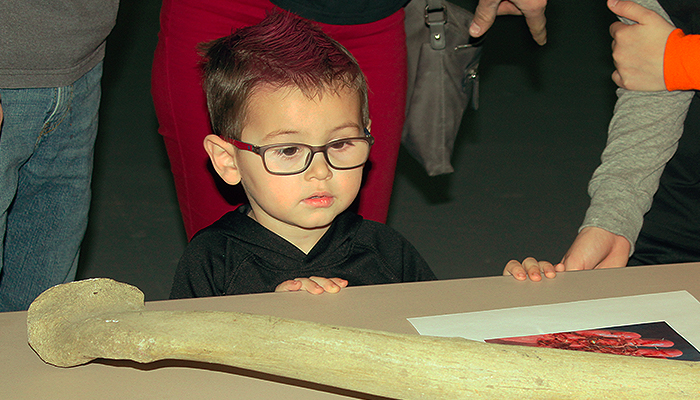
By CRISTINA JANNEY
Hays Post
Visitors took advantage of a free admission at the Sternberg Museum of History on Sunday to learn more about predator and prey relationships.
Staff and volunteers shared museum specimens with guests and talked about how different creatures integrate into to complex food webs.
David Levering, camps manager, and Chase Shelburne, curatorial assistant, discussed the food web in western Kansas and how energy moves through the food web.
The major source of energy is sunlight, which plants use for photosynthesis to grow leaves, seeds and berries.
“In insects and small mammals and small birds eating those plant products, they grow their bodies and sustain themselves, but then they will be frequently eaten by predators,”Levering said. “So what we will see is lots of little animals that eat those plant products and then fewer animals that eat other animals because there is less and less energy and it can’t keep as many alive.”
You might see hundreds of mice in fields, but only a few hawks or foxes, he said.
Primary consumers or plant eaters in Kansas can include cottontail rabbits, prairie dogs or cotton rats.

“Then we have a lot of these snakes and lizards, which form a strange section in a trophic area. Like I mentioned they can eat a lot animals that are on the food web, and they can be eaten by some of the animals on the same level. And then of course they are prey for bigger animals like our shrikes and hawks and some owls. We have tons of snake species — some of which eat each other as well.”
Birds of prey have adaptions such as a hooked beaks to better eat their prey. Least weasels change color from a brownish grey to white during the winter months.
Evolution and adaptation is a constant weapons race that is in a perpetual tie.
Trevor Williams, Fort Hays State University graduate student in geoscience, gave the example of a crab trying to eat a shellfish. The shellfish grow thicker shells with more defensive spikes to keep the crabs from eating them. The crabs grow bigger claws to better crack the shells.
Williams said it is like “Alice in Wonderland” when Alice is in the Red Queen’s castle. She is running as fast as she can, but it as if she is standing still.

“That is a way to explain what is going on in the evolutionary arms race,” he said. “Every species is evolving in response to other species. That includes both predators and prey and competition, so it is trying to get any edge it can. When everyone else is doing the same thing, everyone is stuck in one place. They call that the Red Queen’s Hypothesis.”
Another example is rattlesnakes and squirrels. Over time squirrels have developed a tolerance to snakes’ venom. The snakes with the strongest venom are the ones that eat. As a result the snakes’ venom grows stronger with successive generations.
Amber Michels, FHSU graduate students in geoscience, discussed the arctic food web, which is supported by the tiny phytoplankton and krill.
When the sun is up from March to September, there are large plankton blooms. Baleen whales only feed on the tiny krill, so they constantly move from the Arctic to the Antarctic in search of food. Arctic birds, such as terns, puffins and loons, eat fish that eat the krill. Freshwater fish in the arctic have a type of anti-freeze that keeps them from freezing.
Julie Robben said the event was an opportunity for her family to get out of the house after so much cold weather.
“We wanted to learn lots about animals and science,” Caleb Robben, 7, said.
